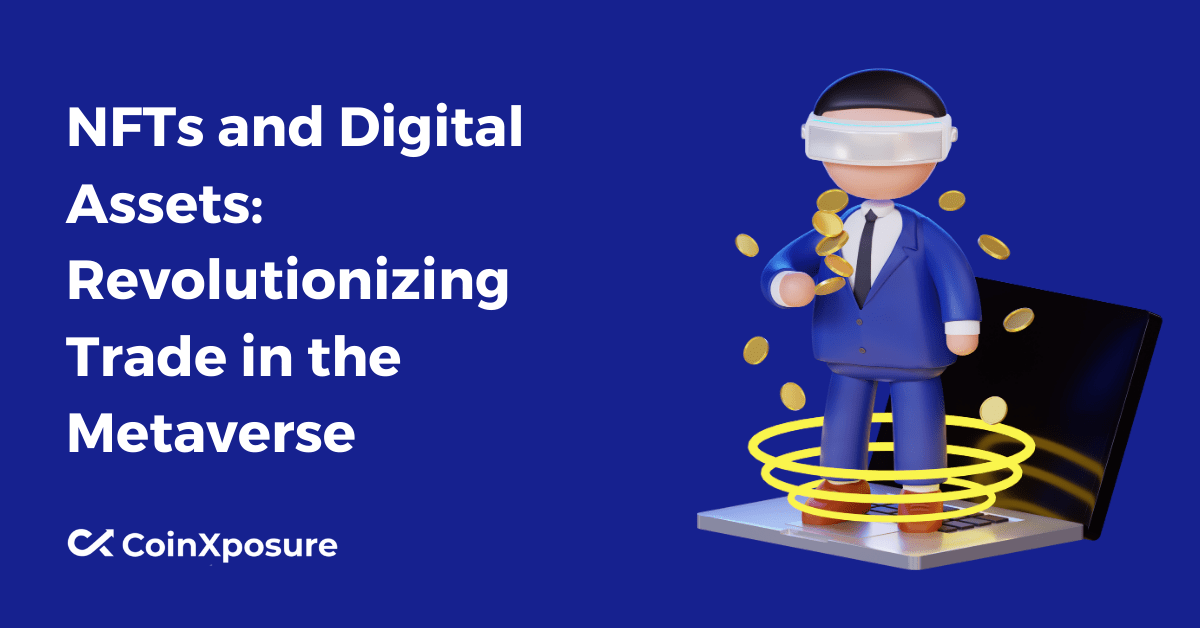Welcome to the transformative intersection of NFTs (Non-Fungible Tokens) and Digital Assets, where a revolution in trade is unfolding within the expansive realms of the Metaverse.
Non-Fungible Tokens, powered by blockchain technology, have redefined ownership and scarcity, while digital assets find new significance in virtual spaces.
Together, they propel an evolution in commerce, art, gaming, and beyond, shaping a future where the boundaries between physical and digital ownership blur within the dynamic landscapes of the Metaverse.
Join us as we delve into the exciting landscape where innovation, technology, and decentralized economies converge.
NFTs Explained
NFTs, or Non-Fungible Tokens, are unique digital assets verified using blockchain technology. Unlike cryptocurrencies such as Bitcoin or Ethereum, NFTs represent ownership of specific items, like digital art, music, videos, or virtual real estate.
Each NFT is distinct, providing indisputable proof of authenticity and ownership through blockchain’s decentralized and secure ledger.
Smart contracts enable programmable functionalities, like automatically compensating creators with a percentage of resale transactions.
NFTs have gained immense popularity for their ability to establish true ownership and rarity in the digital realm, fostering new possibilities for creators and collectors alike.
Digital Assets in the Metaverse
Digital assets in the Metaverse encompass a diverse range of virtual goods, commodities, and experiences within digital environments.
As the Metaverse evolves, traditional concepts of ownership extend to intangible entities, creating a dynamic economy.
From virtual real estate and in-game items to digital art and social tokens, these assets hold intrinsic value within immersive online spaces.
Ownership and scarcity become pivotal, shaping a landscape where individuals can buy, sell, and trade digital assets, contributing to the emergence of vibrant and interconnected virtual economies.
Interoperability further enhances the fluidity of these assets across different platforms and experiences within the expanding Metaverse.
NFTs and Art
NFTs have profoundly impacted the art world, revolutionizing how we perceive, buy, and sell digital artworks. Artists now tokenize their creations as NFTs, turning them into unique and tradable assets on blockchain platforms.
This innovation ensures verifiable ownership, provenance, and scarcity, addressing challenges in the digital art market.
Collectors can securely own and trade these NFT-based artworks, while creators benefit from programmable royalties through smart contracts, earning a percentage on secondary sales.
The intersection of NFTs and art transforms the traditional art market and empowers artists in unprecedented ways, democratizing access and fostering a global digital art renaissance.
NFTs in Gaming
NFTs have introduced a paradigm shift in the gaming industry by tokenizing in-game assets. These non-fungible tokens enable true ownership of virtual items, empowering players to buy, sell, and trade assets across games.
This player-driven economy provides a new dimension to gaming, as gamers can monetize their efforts and investments.
Additionally, NFTs enhance the concept of scarcity and uniqueness in virtual items, fostering a sense of exclusivity.
The interoperability of these assets further allows for cross-game compatibility, unlocking exciting possibilities for gamers and reshaping the dynamics of virtual economies within the gaming landscape.
Challenges and Criticisms
The rise of NFTs and digital assets in the Metaverse is not without challenges and criticisms:
- Environmental Concerns
- Legal and Copyright Issues
- Market Speculation and Volatility
Environmental Concerns
The energy consumption associated with blockchain networks, particularly in proof-of-work systems, raises environmental sustainability concerns and triggers debates about the ecological impact of NFT transactions.
Legal and Copyright Issues
NFT ownership and intellectual property rights can be complex, leading to legal disputes and challenges in defining ownership boundaries, especially in digital art and media.
Market Speculation and Volatility
The NFT market has witnessed significant price fluctuations, speculative bubbles, and market volatility, posing risks for creators and investors and raising questions about the long-term stability of NFT valuations.
Navigating these challenges is crucial for the continued growth and acceptance of NFTs and digital assets, prompting ongoing discussions around sustainability, legal frameworks, and market dynamics.
Future of NFTs and Digital Assets in the Metaverse
The future outlook for NFTs and digital assets in the Metaverse is marked by ongoing innovation and transformative possibilities:
- Integration Across Industries
- Technological Advancements in the Metaverse
- Regulatory Developments
Integration Across Industries
NFTs are likely to find broader applications beyond art and gaming, integrating into industries such as music, entertainment, real estate, and education, unlocking new ways of ownership and value creation.
Technological Advancements in the Metaverse
Evolving technologies, including augmented reality (AR) and virtual reality (VR), will enhance the immersive experiences within the Metaverse, expanding the scope and potential use cases for digital assets and NFTs.
Regulatory Developments
The regulatory landscape surrounding NFTs is expected to evolve, addressing concerns related to legal frameworks, intellectual property, and environmental impact, providing a more stable and secure environment for participants.
As NFTs mature, the Metaverse will likely witness a dynamic fusion of technology, creativity, and commerce, shaping a future where digital assets play a central role in how we create, share, and interact within virtual spaces.
Conclusion
The synergy between NFTs and digital assets is redefining trade in the Metaverse, marking a pivotal moment in the evolution of digital ownership and commerce.
The unique characteristics of NFTs, from verifiable authenticity to programmable royalties, have propelled their adoption across various industries, with a significant impact on art, gaming, and beyond.
Despite challenges such as environmental concerns and legal complexities, the future outlook remains promising.
The ongoing integration of NFTs across industries, advancements in immersive technologies, and regulatory developments signify a continued maturation of the Metaverse economy.
As we navigate this digital frontier, the intersection of NFTs and digital assets not only transforms how we perceive and trade virtual goods but also empowers creators, collectors, and gamers in unprecedented ways.
The Metaverse unfolds as a dynamic landscape, where innovation and decentralized economies converge, paving the way for a future where the boundaries between physical and digital ownership blur in exciting and unforeseen ways.












